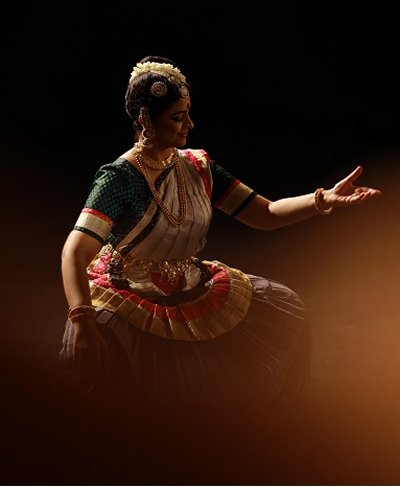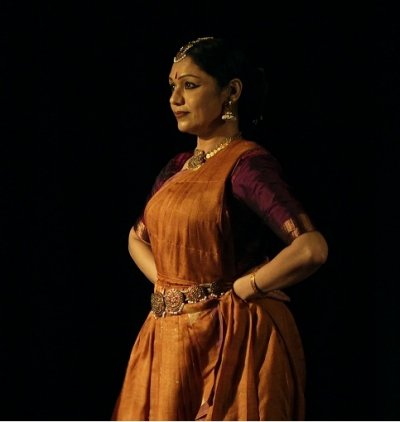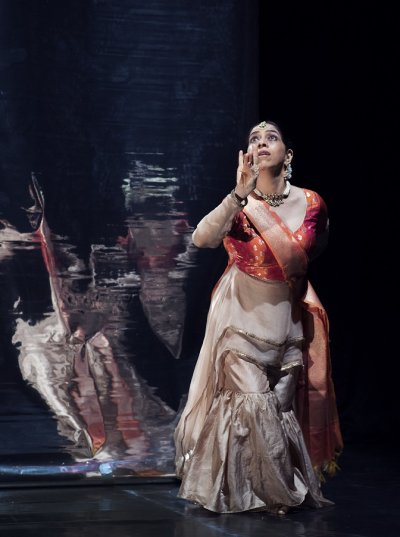
|   |

|   |
Anvesana - Reflections in Solitude - Janani Murali e-mail: janani.meenakshi@gmail.com Photos courtesy: Sampradaya Dance Creations May 26, 2021 Over the past year, through the various trying phases that the pandemic has brought on, it is probably in the arts that many have found solace. One acknowledges that artistes themselves have had to face severe challenges but this past year has also been a compelling time to pause and introspect. The isolation has probably offered a space to dive deeper into their practice; to find newer possibilities perhaps or find themselves and their art in new light. Lata Pada, Founder and Artistic Director of Sampradaya Dance Creations, curated Anvesana- a digital edition for 2021 that brought forth work that was born out of this pause, introspection and reflection, and therefore suitably captioned ‘Reflections in Solitude.’ Anvesana premiered commissioned work by 4 leading artistes – Bijayini Satpathy in Odissi, Methil Devika in Mohiniattam, Rama Vaidyanathan in Bharatanatyam and Aditi Mangaldas in Kathak - over 2 weekends on 8-9 May and 15-16 May on Shaale.com. Each of these artistes has been inspiring an entire generation of dancers over the years. This digital festival only heightened the adulation and got me thinking of the lessons that we could possibly learn from their respective works. Leading up to the premiere, the weekends in April presented each of the artistes in conversation with Lata Pada, elaborating on the ideation, choreography and execution of their respective works. While each artiste resonated with a unique rhythm and anchored their work on ideas and thoughts that were unique to their journey, a collective takeaway would be the phenomenal clarity in solitude that they have drawn from- a lesson for any young dancer dealing with the angst that the pandemic has brought on. Movement with purpose  Bijayini Satpathy Bijayini Satpathy presented ‘Call of Dawn’, exploring one Raag through varied soundscapes and visuals. Celebrating the sensuous beauty of a woman who acknowledges the masculine and feminine within through the Ardhanarishwara stotra, ‘Oned’ transitioned into ‘Ahirini’ with the young lady preferring the gentle, playful Krishna over the fearsome Shiva. While the Ardhanarishwara stotra has seen many interpretations from various artistes over time, Bijayini’s interpretation did not rely on the gross and explicit differences that are usually assumed as masculine and feminine, but rather interestingly on the subtle differences in quality. Chakravaka Pallavi followed, based in choreography on the legend of the love birds that separate at dusk and await union at dawn. The strength and simultaneous fluidity of movements that come with ease are indicative of years of conditioning the body to be in complete sync with itself and the mind that creates. My first lesson from Anvesana was embodied in this performance - Much like the coming together of the masculine and feminine, strength and fluidity, intent and precision come together to form a whole. And in that we find evocative dance. ‘Not etched in stone’ humanistic perspectives  Methil Devika Ahalya is a character of the Ramayana that has caught the imagination of dancers in various versions and pieces. Having mulled over the possible isolation that many women find themselves in - even outside the pandemic situations - because of regressive patriarchal norms, Methil Devika says that of the many people or characters who came to mind with the term ‘isolation’, Ahalya was one. On an exploration through different versions of the Ramayana to see how Ahalya was portrayed, she found Valmiki’s Ramayana to have portrayed human emotion sensitively and realistically. Drawing from key stanzas of the chapters that delineate this episode, Devika strung together a narrative that brought in equal measure story-telling and pure dance - each flowing into the other. My second lesson is one that we have all heard, but is evident here - Only immersive study into the grammar of dance and texts and music makes a piece pliable and viable in the dancer's hands. Traversing the literal and metaphorical connotations of Indira and Rama, the poignant visuals of Ahalya finding the Ramatvam within herself will stay on with the audience. Moving Boundaries: Infinite possibilities  Rama Vaidyanathan Who could have imagined that the very foundational aspects of Bharatanatyam can yield itself in such varied hues? Rama Vaidyanathan in ‘Moving Boundaries’ celebrates the fact that boundaries liberate the dance and dancer. In being rooted through the grammar, one finds the strength to branch out in several different patterns. Finding new meaning in syllables and movement that always have been, this introspective work brings forth the very premise of Bharatanatyam being one of ever expanding horizons. In ‘Dissolving Boundaries’ the imitation of life and art becomes clear. Rama continues to showcase the infinite possibilities of ideation and movement within boundaries. In ‘Merging Boundaries’, spiritual journey and Bharatanatyam grammar flow into each other and lead each other on in ways that truly exemplifies the idea of ‘merging.’ Lesson number three was touched upon in the conversation between Lata Pada and Rama Vaidyanathan before the premiere - that it is the years of sadhana that hold the string to our colourful kites that dance to the winds. In her visualisation of the abstract, in the dynamic visuals that get painted out of each idea, this lesson only became clearer. Hope over storm; Gravity in thought  Aditi Mangaldas Aditi Mangaldas enters your screen with the visual of furious waves. In spite of the rampage of the pandemic, it is the hope of a brighter tomorrow that her work ‘Lost...In the forest’ is anchored on. Working with empty frames symbolizing lost narratives, she explores ‘River in a Boat.’ If narratives have been lost, what has changed - she questions; each time conversing with the frames, through the frames, above or beyond them too. From mirroring the tumultuous months of the pandemic; in her next piece ‘Chan Chan Chipp Chipp’ she uses visuals of distorted reflections, emphasising the alternate realities that we live in today- destruction and loss on one hand; safe confines of a home and banter on the other. But the deer looks up at the moon in hope as do we. The gamut of emotions that the pandemic has churned up in every individual is often difficult to even articulate, but in ‘Lost...In the forest’ one saw them not just brought out but also layered ever so subtly and sensitively. My lesson number four: The gravity of thought that lends itself to careful articulation through movement and visuals is at the very core of sensitive art - one that we need definitely during a crisis but also at all other times if we must engage with the world around us effectively. ‘Anvesana - Reflections in Solitude’ did not happen in silos. The four dance films brought together phenomenal thinkers and their art, musicians and soundscapes that propelled their ideas, on-point lights that became a vital participant and filming that brought these works to life in a way that we may not be able to experience in a live concert.  Janani Murali is a dancer, writer, biologist and ecoprenuer. She is Associate Artistic Director of Padmalaya Dance Foundation, Bangalore, and Executive Member of International Dance Alliance, Bangalore Chapter. |